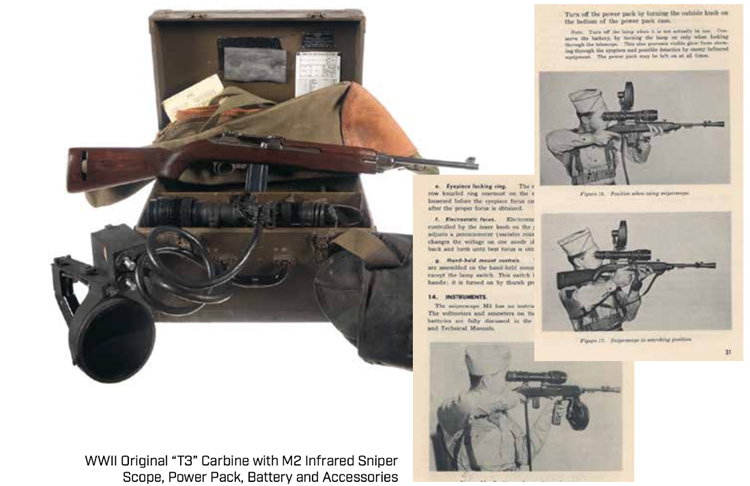Sep 25th 2023
Lesson 6 - We Own the Night! Unveiling the Hidden History of Infrared Night-Sighting Devices
Introduction: Embracing the Shadows
The cover of darkness has always posed challenges for military operations, pushing innovators to develop cutting-edge technologies that allow soldiers to thrive under the shroud of night. We dive into the fascinating world of infrared night-sighting devices, focusing on the rare and impactful T3 carbines equipped with infrared sniper scopes. These devices, developed during World War II, played a pivotal role in altering the course of warfare and have left an enduring mark on military history.

The Birth of the T3 Carbines
The story begins with the production of a limited number of T3 carbines, a unique and specialized variant developed by the Inland Division of General Motors and Winchester. These carbines were distinct from the widely used M1 carbines, with only around 811 units produced by Inland and 1,108 by Winchester. The year 1944 marked a crucial turning point as the United States Corps of Engineers collaborated with General Motors, Bell and Howell Company, and Cornell Dubliner Electric Corporation to introduce the US Carbine, Caliber .30 in, M3, or T3.

Infrared Vision Unveiled
The T3 carbines were not just ordinary weapons; they were designed to accommodate various models of infra-red night-sighting devices. These devices, known as infrared sniper scopes, were intended to provide a significant advantage in nighttime combat scenarios. The T3 carbines were specifically tailored to utilize the original M2 Infrared Sniper Scope, which featured a large infrared emitter lens beneath the stock and a smaller M2 detector scope mounted on the receiver's top. These scopes were capable of detecting targets at an effective range of about 70 yards.
The Japanese Campaign and the Sniperscope's Impact
Developed in 1943 by the Army, the infrared scopes were aimed at countering Japanese infiltration tactics. Despite the deployment of fewer than 500 units, the Sniperscope played a crucial role, contributing to approximately 30% of the total Japanese casualties resulting from small-arms fire in the first week of the Okinawa campaign. This remarkable achievement highlighted the potency of this innovative technology.
Evolution of Night Vision Technology
As the Corps of Engineers concentrated on enhancing night vision sights, the Ordnance Department pursued the development of the M3 Carbine. Instead of creating a distinct T-3 carbine, they opted to transform standard M1 or M2 carbines into night vision-ready platforms using straightforward conversion kits. The resulting system integrated an active infrared light source and a viewing telescope, weighing 7.2 pounds for the telescope, light source, and handle. The entire setup, inclusive of battery and power supply, weighed 28 pounds, offering an effective range of approximately 135 yards.
Surplus and Beyond: The Legacy of Infrared Scopes
With time, surplus units of the "20,000 volt Set No. 1" sniper scopes entered the market, repurposed for commercial use by hunters and bird watchers. However, the legacy of infrared technology didn't stop there. Companies like Polan Industries and Varo, Inc. supplied the U.S. Army with the AN/PAS-4 infrared scope for the M14 rifle, extending its capabilities. This technology found its way to training scenarios and even service in the Republic of Vietnam, solidifying its relevance on the battlefield.

Expanding Horizons: International Perspectives
While the U.S. was at the forefront of infrared technology, other countries were also making strides. The Ferro 51 GEN 0 binoculars with an infrared light source, developed by AEG, De Oude Delft, and Eltro in the 1950s, exemplify international efforts in night vision advancements. This technology, adopted by German and Swiss army forces, provided an intriguing alternative perspective.

Conclusion: Illuminating the Past
The history of infrared night-sighting devices is a testament to human innovation and adaptability. From the inception of T3 carbines with their specialized scopes to the evolution of versatile systems like the AN/PAS-4, these technologies reshaped the landscape of warfare and beyond. As we reflect on the hidden chapters of military history, we're reminded that even in the darkest of hours, human ingenuity has the power to illuminate the path forward.
